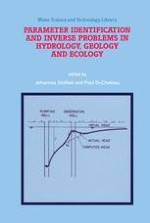The Workshop on Parameter Identification and Inverse Problems in Hydrology, Geology and Ecology, Karlsruhe, April 10-12, 1995, was organized to bring to gether an interdisciplinary group drawn from the areas of science, engineering and mathematics for the following purposes: - to promote, encourage and influence more understanding and cooperation in the community of parameter identifiers from various disciplines, - to forge unity in diversity by bringing together a variety of disciplines that attempt to understand the reconstruction of inner model parameters, un known nonlinear constitutive relations, heterogeneous structures inside of geological objects, sources or sinks from observational data, - to discuss modern regularization tools for handling improperly posed pro blems and strategies of incorporating a priori knowledge from the applied problem into the model and its treatment. These proceedings contain some of the results of the workshop, representing a bal anced selection of contributions from the various groups of participants. The reviewed invited and contributed articles are grouped according to the broad headings of hydrology, non-linear diffusion and soil physics, geophysical methods, mathematical analysis of inverse and ill-posed problems and parallel algorithms for inverse problems. Some of the issues adressed by the articles in these proceedings include the rela tion between least squares and direct formulations of inverse problems for partial differential equations, nonlinear regularization, identification of nonlinear consti tutive relations, fast parallel algorithms for large scale inverse problems, reduction of model structures, geostatistical inversion techniques.
